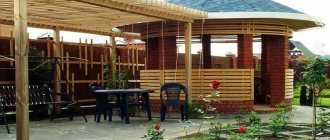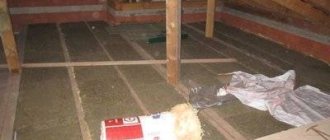Project 23 battleships
The unsinkability of the ship was ensured when the unarmored part of the ship was destroyed and two 21-inch torpedoes were simultaneously hit in the bottom or three torpedoes in the boules. Much attention was paid to the quality and strength of connecting armor plates in various ways: with rivets in three rows in a checkerboard pattern, with dowels, etc. The possibility of using welding was considered, which gradually became part of the practice of Soviet and foreign shipbuilding (welded armor decks with a thickness of 12– 30 mm German cruisers of the Admiral Hipper type). Based on the results of a war game held in 1938 at the Naval Academy with training shooting on a training stand, it was believed that Soviet ships of Project 23 would have advantages over foreign battleships. At the same time, the conclusion was made about the “benefit of the 85-105 mm caliber for anti-aircraft artillery,” which subsequently required significant clarification.
Hull and superstructure design
Booking
armor belt: 375—420 mm, belt height 6.27 m, tilt angle 5°,
bulkheads: 230-365 mm,
barbette: 425 mm,
gun turrets: 495 mm,
deck: 25+155+50 mm,
deckhouse: 425 mm
Anti-torpedo protection
Anti-torpedo protection was designed for a charge explosion of up to 750 kg of TNT equivalent. The anti-torpedo protection had a length of slightly less than 70% of the ship’s length along the vertical line. Over most of its length, its depth was at least 7.5 m (at the midships - 8.2 m) and only at the bow traverse of the citadel (the 64th frame) it decreased to 7.1 m. In the aft part of the citadel, for design reasons, instead The Italian system was used in favor of the American one with four longitudinal bulkheads. For an objective comparative assessment of various protection systems, in 1937-1938 a series of experiments was carried out in Nikolaev with the detonation of 24 large-scale (1:5) compartments manufactured by Plant No. 200 of seven systems known at that time. The results of these tests, carried out by the commission of Captain 2nd Rank Lundyshev, selected the two most effective ones: the American one, used on the battleship West Virginia, and the Italian Pugliese-Littorio class. Based on these results, in February 1938 they proposed replacing the Italian system with an American one on the Project 23 ship, considering it more preferable, both in terms of explosion resistance and design and operational qualities. The proposal was rejected due to fears that the rework would delay the ship's laying date.
Power plant
The ship's power plant included three main turbo-gear units (GTZA) with a capacity of 67,000 hp each. With. (maximum 77,000 hp) and six water-tube boilers.
Characteristics of the power plant
The steam output of one boiler is 162 t/h (maximum 185 t/h), outlet pressure 37 atm. at a temperature of 380. The GTZ of the battleship was unified with the units of the Project 69 heavy cruiser.
The Chek-Su.VK project did not pass the presidential filter
352 2 min.
Vladimir Putin’s order did not help resolve the conflict between the initiators of the Yenisei Ferroalloy Plant project in the Krasnoyarsk Territory and the regional authorities. An environmental assessment was never carried out, and the presidential administration itself came to the conclusion that construction was inappropriate. The main victim was Vnesheconombank, which managed to issue 8 billion rubles for the development of the project.
The construction of the EFZ in the Krasnoyarsk Territory did not go beyond the project
Photo: Evgeny Kurskov, Kommersant / buy photo
Last Friday, the deadline for the instruction given in June by Vladimir Putin to the Governor of the Krasnoyarsk Territory, Lev Kuznetsov, to conclude a tripartite agreement on the construction of the Yenisei Ferroalloy Plant (EFZ) with the initiator of the project, Chek-Su.VK CJSC, and VEB, which provides project financing, expired. The agreement was supposed to be signed upon a positive result of the environmental assessment, the organizer of which was to be jointly determined by the regional authorities, the Ministry of Industry and Trade of the Russian Federation, VEB, Rospotrebnadzor and Chek-Su.VK. But it was not possible to carry out the examination on time - before November 1.
Moreover, yesterday the “Krasnoyarsk Against” movement circulated the response of the Russian Presidential Administration to the call of social activists to ban the project. “In Krasnoyarsk, a stable position of the population has formed to prevent the construction of the Federal Economic Zone. Further implementation of the project of Chek-Su.VK CJSC at the previously selected production site is unacceptable not only from the point of view of taking into account public opinion of the population, but also from the point of view of environmental safety,” notes the letter dated October 8. At the same time, officials refer to the findings of Rostechnadzor, which pointed to the background environmental pollution already existing in the city, which significantly exceeds established standards.
CJSC Chek-Su.VK is owned by Georgy Ramzaitsev (co-owner of Urals Energy), Viktor Khrolenko and the close JSC Russian Railways Rosvagonmash. The project includes the development of the Usinsk manganese deposit in the Kemerovo region (128 million tons of ore), the construction of a mining and processing plant with a capacity of 760 thousand tons of concentrate per year and an EFS with a capacity of 600 thousand tons of ferroalloys per year. Investments in the project are estimated at 22 billion rubles.
“Chek-Su.VK” acquired 450 hectares of land and buildings in the Emelyanovsky district of the region back in 2008. In July 2009, VEB approved a loan to the company for 16.6 billion rubles, and in September 2011, the Federal Federal Law received the conclusion of Glavgosexpertiza. It was planned that the first stage of the project would be ready by 2014, but the company still does not have a construction permit, since the regional authorities believe that the Federal Zone will harm the environment.
The head of the Council of the Civil Assembly of the Krasnoyarsk Territory, Alexei Menshchikov, whom the governor instructed to oversee the examination, believes that the region “did everything on its part,” in particular, it chose the expert organization - the Krasnoyarsk Scientific Center SB RAS (KSC), but “Chek-Su.VK” “In 2.5 months I still haven’t concluded an agreement and haven’t paid the organization for the examination.” Director of project management at Chek-Su.VK Alexander Novikov told Kommersant on Friday that, on the instructions of the president, all interested parties must coordinate the choice of the organization, but representatives of the KSC have previously repeatedly spoken out against the EFL. According to him, the choice of experts caused bewilderment among the company itself, VEB and the Ministry of Industry and Trade, which initiated a meeting on August 19 with presidential aide Andrei Belousov, where an agreement was reached on a new choice of experts. It was not possible to contact Mr. Belousov’s representative on Friday; VEB and the Ministry of Industry and Trade declined to comment. But Kommersant managed to get acquainted with a letter from the Deputy Head of the Ministry of Industry and Trade Yuri Slyusar to Lev Kuznetsov dated September 3, which confirmed the fact of the meeting. A list of ten expert organizations is attached to the document (KSC is not among them). Alexey Menshchikov does not comment on the letter, and Chek-Su.VK believes that the regional authorities “simply ignore” the appeal of the Ministry of Industry and Trade. Kommersant’s sources say that the situation is also worrying VEB, which invested over 8 billion rubles in the project. out of 11 billion rubles invested in project documentation, field preparation and the road to it. At the same time, VEB has only the land and buildings of Krastyazhmash as collateral without a license for the field.
Anatoly Dzhumailo; Dmitry Malkov, Krasnoyarsk
Modern project management system in construction
Today, demands in organizing construction processes have changed significantly, as significant changes have occurred in the field of project management. Other forms of management are dictated by the need to optimize and speed up work processes, and new advances have appeared in the world of computing.
Currently, the use of information systems in construction management is necessary. However, the management model has not changed radically. The entire list of events in the workflow has been preserved in its previous form.
The work package in the control infrastructure looks like this:
- Feasibility study of engineering searches for project implementation.
- Creation of design and estimate documentation.
- Preparation for zero cycle work.
- Construction of the object.
- Ensuring quality control.
- Inspection of the building before delivery.
This is interesting!
“Building design: types, stages”
More details
Modern residential building construction systems have become more efficient nowadays. There have been significant changes in the communication system. They are now more reliable due to increased functionality. This is why it is easy to coordinate the individual groups involved in the project.
The general management infrastructure can provide a wide range of technical procedures related to logistics, document circulation, processing of engineering research data, structural calculations, etc. The systems are so powerful that they can perform many operations, and the operator has the ability to generate estimates on various parameters based on analysis.
Traditional project management in construction
The process of managing a housing construction project is complex. And if it is well thought out, then the project deadlines and safety will be normal, and the operating time will not cause concern.
There are people who believe that strategic or operational construction planning is too simple. Definitely, they will discover that it is not enough to control, you need to take into account all the features.
Today, it has been proven in practice that a boss who has gone through all stages of development from the very beginning to a high position is the best in his field. Because he knows as much as possible about his work. Therefore, the advantage in organizing construction will be with the company that is well versed in this topic.
It is difficult to ensure logistics during project implementation and the versatility of the work processes produced, therefore an organizational management model in construction is necessary. To achieve the set goals, you need someone who will take the lead and control not only the project participants, but also correctly distribute resources. And the construction management system can handle this.
Having optimized the entire working period at each level, coordination will become the mission of the management structure. It is necessary to be ready at any time to adjust financial costs, reduce the role of factors that can have a negative impact on the entire process, and also adjust tactics for construction and installation work, if necessary.
RSSM project offices
“The goal of the project offices is to create a sustainable support mechanism for rural activists who are ready to develop their small homeland. Representatives of project offices are already conducting consultations for villagers, we are seeing the first results - those who applied have either already received a grant, or have submitted applications and are waiting for the results of the competitions,” comments the Chairman of the Russian Union of Rural Youth, Yulia Ogloblina.
The Russian Union of Rural Youth is holding a competition to identify teams capable of creating a project office - a sustainable infrastructure for the support and development of civic activity, where young activists will work on their initiatives for the development of villages. The winners of the competitive selection will receive methodological and organizational support for their activities, consulting and administrative support, and the opportunity for additional training and advanced training.
The competition is held in three stages: Stage 1: until January 19, 2021 – accepting applications from project teams to participate in the Competitive selection;
Stage 2: until January 31, 2021 – consideration by the Expert Commission of received applications for compliance with the application filing requirements provided for by the Regulations, invitation to the third stage;
Stage 3: until February 29, 2021 – evaluation of applications, summing up and determination of the winners of the Competitive Selection by the Expert Commission.
The team must include at least 2 representatives of NPOs and other associations or organizations. Each team must also have a leader who will lead, coordinate, and also interact with the competition organizing committee during the selection process.
Criteria for evaluating participants: – Experience in conducting events and implementing projects (programs) in a constituent entity of the Russian Federation aimed at increasing civic activity in rural areas; – Prospects for the development of a project office in a constituent entity of the Russian Federation, the ability to implement the functions of a project office (relevance for a given territory, availability of an action plan); – Availability of a system of interaction with partners at the regional and federal levels (letters of support, agreements); – Number of employees and volunteers (volunteers) of the project office; – The uniqueness of the activities, mechanisms and approaches that are planned to be used in the work of the project office; – Planned coverage of the rural population during the work of the project office; – The area of the existing/proposed premises for the project office, technical characteristics and material equipment.
The winners of the competitive selection will be announced at the All-Russian seminar for project teams, which will be held in February 2021 in Moscow.
They will receive the necessary support in creating a project office - methodological recommendations (standard model of a project office, instructions), organizational support, administrative support.
Teams that pass the third stage of the competitive selection, but do not become winners, will be able to become partners of regional resource centers for volunteering and the Russian Union of Rural Youth.
More details about the terms of the competition can be found in the Regulations. The project is being implemented using a grant from the President of the Russian Federation provided by the Presidential Grants Fund.
Hurry up to apply - don’t miss the chance to join the team of experts and create a center of attraction for the best rural activists in the country!











